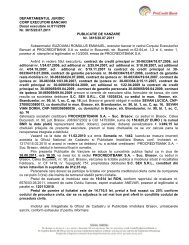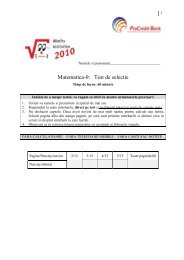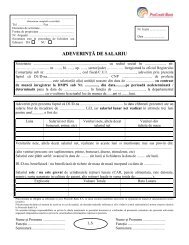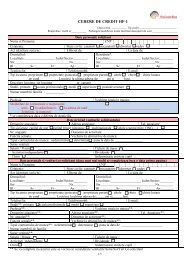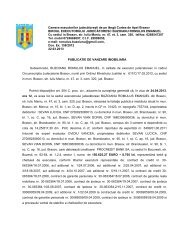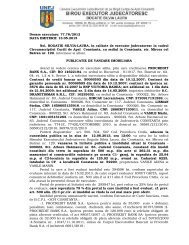Annual Report 2010 - ProCredit Bank
Annual Report 2010 - ProCredit Bank
Annual Report 2010 - ProCredit Bank
You also want an ePaper? Increase the reach of your titles
YUMPU automatically turns print PDFs into web optimized ePapers that Google loves.
higher than EUR 30,000. These loans are graded 2-4 in the <strong>Bank</strong>’s<br />
loan loss provision methodology. However, if a loan was restructured<br />
and the restructuring led to a decrease of the interest rate, all<br />
loans granted to the respective client will be classified as impaired,<br />
regardless of the arrears level.<br />
Past due but not impaired loans<br />
Loans and securities where contractual interest or principal payments<br />
are past due but the <strong>Bank</strong> believes that impairment loss is<br />
not appropriate on the basis of the level of security / collateral available<br />
and / or the stage of collection of amounts owed to the <strong>Bank</strong>.<br />
Allowances for impairment<br />
The <strong>Bank</strong> establishes an allowance for impairment losses that<br />
represents its estimate of incurred losses in its loan portfolio. The<br />
main components of this allowance are a specific loss component<br />
that relates to individually significant exposures, and a collective<br />
loan loss allowance established for groups of homogeneous assets<br />
in respect of losses that have been incurred but have not been identified<br />
on loans subject to individual assessment for impairment (refer<br />
to Note 3 (h) (vii) and Note 5).<br />
Write-off policy<br />
The <strong>Bank</strong> writes-off a loan / security balance (and any related allowances<br />
for impairment losses) when it determines that the loans<br />
/ securities are uncollectible. This determination is reached after<br />
considering information such as the number of days in arrears.<br />
A loan is considered uncollectible when it has more than 180 days in<br />
arrears for loans with principal outstanding amounts plus accrued<br />
interests less unamortised fee (amortized cost) below equivalent<br />
EUR 10,000 or if it has more than 360 days in arrears for loans with<br />
amortised cost greater than equivalent EUR 10,000 but up to EUR<br />
30,000. For loans with amortised cost higher than EUR 30,000 the<br />
write off would be performed after 360 days of arrears. For these<br />
loans in case of pending court transactions, i.e. if it is probable that<br />
the loan will be finally recovered via the execution of collateral the<br />
item will be kept on the balance sheet. Credit Risk Department (in<br />
case the legal execution did not start) or Legal Recovery (in case<br />
the legal execution was initiated) will make the proposal for writing<br />
off (for loans whose amortised cost > EUR 30,000 equivalent) to<br />
<strong>Bank</strong>’s Managers who will decide upon it.<br />
Collateral<br />
The <strong>Bank</strong> holds collateral against loans and advances to customers<br />
in the form of pledge over cash deposits, mortgage interests over<br />
property, guarantees and other pledge over equipments and/or receivables.<br />
Estimates of fair value are based on the value of collateral<br />
assessed at the time of borrowing, and generally are not updated<br />
except when a loan is individually assessed as impaired, except for<br />
mortgage interests over property which are reassessed yearly.<br />
Collateral generally is not held over loans and advances to banks.<br />
According to the Counterparty Risk Management Policy and Strategy,<br />
the only type of eligible collateral for these exposures is cash<br />
deposits. Collateral usually is not held against investment securities,<br />
and the <strong>Bank</strong> did not have such exposures as of 31 December<br />
<strong>2010</strong> or 2009.<br />
An estimate of the total value of collateral and other security enhancements<br />
held against financial assets is shown below:<br />
Loans and advances to customers Loans and advances to banks<br />
in EUR<br />
Against individually impaired<br />
31 December <strong>2010</strong> 31 December 2009 31 December <strong>2010</strong> 31 December 2009<br />
Mortgages 5,662,897 1,202,001 – –<br />
Personal guarantees 3,588,677 1,424,541 – –<br />
Inventories 806,294 189,621 – –<br />
Others – – – –<br />
Against collectively impaired<br />
Financial Statements 59<br />
Mortgages 160,776,403 145,533,854 – –<br />
Personal guarantees 152,004,606 273,356,788 – –<br />
Inventories 44,216,749 42,173,862 – –<br />
Others 500,089 288,860 – –<br />
Total 367,555,717 464,169,527 – –<br />
The <strong>Bank</strong>’s credit portfolio risk is naturally limited by the credit<br />
strategy resulting from the business model; in particular the focus<br />
on small and very small loans and denominated mostly in RON show<br />
the distribution of loan portfolio by loan destination for 31 December<br />
<strong>2010</strong>:<br />
in EUR Working capital Agriculture Housing Consumer Other Total<br />
Less than EUR 10,000 27,540,100 20,658,688 2,681,297 293,627 616,248 51,791,959<br />
EUR 10,000 to 30,000 28,104,548 8,192,321 996,421 687,918 325,994 38,307,202<br />
EUR 30,000 to 150,000 37,971,247 8,154,211 780,071 217,878 216,050 47,339,457<br />
More than EUR 150,000 27,635,785 5,200,208 103,394 148,078 – 33,087,466<br />
Total 121,251,680 42,205,427 4,561,183 1,347,502 1,160,291 170,526,084








